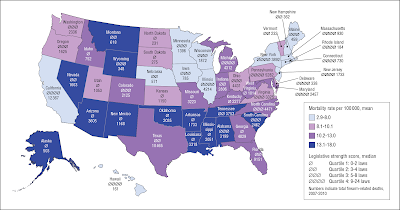AP is reporting "More Gun Laws = Fewer Deaths, 50-State Study Says." Unfortunately, the study is transparently biased and misleading. The Associated Press reported the following information about the study:
The results are based on an analysis of 2007-2010 gun-related homicides and suicides from the federal Centers for Disease Control and Prevention. The researchers also used data on gun control measures in all 50 states compiled by the Brady Center to Prevent Gun Violence, a well-known gun control advocacy group. They compared states by dividing them into four equal-sized groups according to the number of gun laws.
The results were published online Wednesday in the medical journal JAMA Internal Medicine.
Editorial author Dr. Garen Wintemute, director the Violence Prevention Research Program at the University of California, Davis, said the study doesn't answer which laws, if any, work.The actual study can be found here, but we pillaged the most informative graphic for you below. Study it closely.
Wintemute said it's likely that gun control measures are more readily enacted in states with few gun owners a factor that might have more influence on gun deaths than the number of laws.
The study breaks states into groups, but city laws are not taken into account. So the two progressive gun violence capitals, Washington D.C. and Chicago are excluded and misclassified respectively. Chicago is classified by Illinois' gun laws and Washington D.C. is excluded.
Considering that Chicago has more annual gun deaths than America loses in the Afghanistan War, it is hard to take this study serious. California's gun restriction number in the study is 22, while Illinois gets an 11.5. Further, Chicago related murders in East Chicago, Indiana and Gary, Indiana are deflected from Illinois' gun deaths count.
The numbers:
- Chicago, Illinois murders in 2008 were 18 per 100,000 residents (510 total). The highest comparable number in the study was Louisiana at 10.1.
- East Chicago, Indiana murders in 2008 were 56.9 per 100,000 residents (17 total).
- Gary, Indiana murders in 2008 were 51.2 per 100,000 residents (49 total).
Suicides are counted. When you remove suicides and look at only Homicides you come to a very different conclusion. Lets be serious. If people are allowed to have guns, they may use them to commit suicide, but that is not the implication of "More Gun Laws = Fewer Deaths." If someone commits suicide by drugs or jumping from a highway overpass instead of by a gun, society does not benefit from the gun law that influenced the method of suicide.
Either the study authors believe that suicides are caused by guns or they are using suicide victim statistics to dishonestly support their political agenda. If there is another explanation, please comment and let me know.
Next, Vermont, North Dakota and New Hampshire "homicide" numbers are reported as "NA" instead of using zero or a very small number. Mysteriously, "overall" fatalities for these states do not match the remaining "suicide" fatalities numbers. As seen in "Climate Change Math", the "overall" fatalities for these states are greater than the "suicide" fatalities despite the NA for "homicide" fatalities. Consider that these numbers are statistical means or mathematical average. Can you say fudge factor?
Here are the numbers from the study. Take note of the "Firearm Fatalities, Mean (SD)" calculation. Can you smell the Doo Doo?:
Here is my chart of data from the study excluding suicides. Washington, D.C. was not added. States without reported homicide numbers were included as zero. Illinois was not corrected to maximum gun laws in this graph. If we had added Washington, D.C. and adjusted Illinois the results would more conclusively display the short comings of the report, but the changes would be inaccurate estimates. Unlike the CDC, who provided the data, we do not allow political goals to push us into deception.
Here is the graph from the study.
This study is actually reporting the obvious. If someone doesn't have a gun, they cannot commit suicide with a gun. It is the Associated Press who has dishonestly spun the study into a political weapon. Consider this study debunked.
Note:
After consideration, this information may become central to comparing gun deaths and crime. The study uses the term "homicide" for non-suicide gun deaths, but this requires closer scrutiny. They may mean simple non-suicide gun deaths, including police shootings, self defense shootings or other "justifiable homicides." That would be blatantly deceptive on their part if they are twisting the language in such a fashion.
















2 comments:
Yeah, the problem is the scale. It treats states as monoliths which is certainly not valid for gun crimes.
I agree with you that the study is biased. not everyone can do good research. some of the research we find on the internet is written by students. students are not always able to write a study correctly and turn to the special services ✏️ not only to indicate the correct research data.
Post a Comment